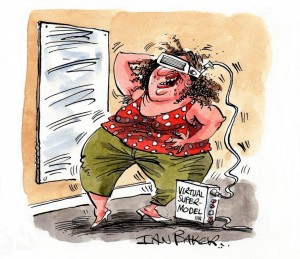
Human Intelligence and Open Source Technologies
Robert Steele on February 1, 2016 in SingularityWeblog
The current fads
Artificial Intelligence (AI) and Virtual Reality (VR) are hot current fads. Both technologies have been a long time in gestation. The ramp-up has taken decades. The current bet – one I do not agree with – is that both of these product categories will take off like the Internet or the mobile phone.
They are fads in part because they are totally disconnected from the larger real world in which we all live. I worry about artificial stupidity being deeply embedded in bureaucratic and machine processes that take on a life of their own, and I worry about so much money being spent on virtual reality that we forget we have been pooping on ourselves with abandon for two centuries and the cesspool is now up to our nose. Nature bats last – no amount of VR is going to change that.
I was one of the first “digital innovators” for the Central Intelligence Agency (CIA). They built the Artificial Intelligence Staff in the Office of Information Technology (OIT/AIS) around me, so when I tell you I am worried about artificial stupidity being embedded in bureaucratic work processes, please believe me. I have seen a trillion dollars’ worth of waste in the last quarter century [an average of $40 billion a year for each of 25 years]. Mostly secret, overwhelmingly technical, the investments in technology by the US intelligence community are predominantly useless in terms of creating a prosperous world at peace, a world that works for all.
Singularity’s Sucking Chest Wound – True Costs
In the real world, everything is connected and everything has a “true cost” in terms of natural capital consumed as well as costs to humans and their communities. True Cost is a combination of non-renewable natural capital (resources) consumed, plus environmental collateral damage, plus human cost in illness and social cost in crime and other factors resulting from, for example, abusive corporate practices tantamount to slavery.
To take just a few examples:
- A standard cotton T-shirt contains 570 gallons of water, 11 to 29 grams of fuel uses, and comes from processes that include child labor. Their production emits volatile compounds, and produces toxins.
- The plastic bottle that contains water requires between six and seven times the amount of water it contains, to make. Other beverages consume more water than they deliver as well – soda consumes 2.02 times its volume in water; beer 4 times, wine almost 5 times, and hard alcohol, 34-35 times.
- Smart phones come with a severe human cost due to the Class A carcinogenics needed to process some of the pieces that go into them. Every smart phone contributes to the hundreds of thousands of Chinese who are in a leukemia ward or dead and buried from leukemia or lung disease. Not to mention the uncounted electronic waste.
Singularity’s Questionable Assumption
Singularity, apart from its obliviousness to true costs that sharply limit future growth irrespective of the advance of technology, firmly believes that machines will overtake humans, whose brains have been under development for millions of years. It also blithely assumes that displacing human labor and engagement with machines – never mind the true costs – will not have social consequences including mass unrest and eventual violence.
As an intelligence professional – both a former spy and leader of analysts – I have watched the National Security Agency (NSA), one example within the trillion in waste I cite above, spend hundreds of millions of dollars in the past quarter century. NSA has never been able to process more than 1% of the data they collect [and is even more paralyzed by data overload now that mass surveillance is the norm]. Nor has NSA been effective with the data they do process, for lack of human linguists skilled in Arabic and Hebrew, among 183 languages we do not speak well in the USA. Here is what James Bamford says in the very last sentence of his book, Body of Secrets: Anatomy of the Ultra-Secret National Security Agency (Anchor, 2002):
Eventually NSA may secretly achieve the ultimate in quickness, compatibility, and efficiency-a computer with petaflop and higher speeds shrunk into a container about a liter in size, and powered by only about ten watts of power: the human brain.
I won’t belabor the limitations of computers, my latest article, Applied Collective Intelligence 2.0, forthcoming in Technological Forecasting and Social Change, addresses the realities that constrain machine intelligence. My purpose in this essay is to advance a concept for saving civilization by integrating human intelligence and a full range of open source technology and information. The idea is to deploy open source concepts across all man-machine domains, not only the information technology domain.
Human Intelligence Toward Hybrid Intelligence
Why does human intelligence matter right now and going forward? Leaving aside the many limitations of computers, which are only as smart as their dumbest line of code and their smallest bits of data in combination; let’s start with the reality that over 80% of what we need to know is not in digital form. In fact the true figure is probably closer to 95% — I am being conservative – and because we only process 1% of Big Data that is collected, according to Mary Meeker. This means that the machine world is working with a tiny fraction–.002 to be exact–of the available relevant data. If you add to that the fact that we are not doing zero-based economic analysis or true cost economics and currently do not have more than baby dosages of data, we end up with what Chris Hedges calls, in a book by this title, Empire of Illusion: The End of Literacy and the Triumph of Spectacle.
A blind faith – that is, one that ignores the true costs in resources and process redesign – in AI and VR to suddenly illuminate our world is dangerous. Only with true-cost accounting, applied predictively to current trends, can we see how challenging are the problems our species –not just humans but all living creatures – face today in the face of resource limitations.
There is certainly a great deal to be said for augmented human intelligence through the use of machine-assisted processing and analysis. Striking that balance, what some call hybrid intelligence, does offer real opportunities for massive positive change. Some researchers, such as Google’s in house singularity maven Ray Kurzweil, believe the machines will triumph and leave us behind; others including me believe machines will augment but never displace humans with their diversity, imagination, and mortality – it is mortality that underlies ethics.
This is an important machine “glitch” seems difficult to resolve: ethics are beyond the ken of a machine. We fool ourselves into thinking code can be written to manage ethical questions. A machine follows instructions, which may seem to be logically complete, but cannot account for novel issues. When AI is reported to make breakthroughs in intelligence, it is often the product of engineers falling in love with their inventions’ output instead of an expression of organic emerging intelligence.
In this specific regard – the domain of intelligence whether human or artificial – I advance three human-centric propositions for consideration.
First, brought forward from my invited 1993 lecture to Paul Allen’s INTERVAL think tank, I suggest
You must avoid at all costs any techniques or tools which isolate individuals or give them the false perception that they can exist remotely, or in their own “virtual” worlds. That is a narcotic and narcissistic vision, and like narcotics and the pool of Narcissus, will ultimately lead to death by overdose or death by drowning.
Second, if you do not embrace full employment (whether in labor or arts), you risk spreading a fatal social disease, one that could lead to social erosion so great as to topple any technical and bureaucratic towers. People seek meaning. Without work, they will find meaning in tearing down the institutions that reject their contributions.
Third and last, mindful that Homo sapiens is in theory supposed to both human and thinking, and with a bow to Micah Sifry’s book The Big Disconnect: Why The Internet Hasn’t Transformed Politics (Yet), as well as my own Foreword to Stephen E. Arnold’s CyberOSINT: Next Generation Information Access, I would point out that we still do not have properly integrated and universally-available tools for information-sharing and sense-making.
Machine intelligence and complex systems integration is expensive and a work in progress. Now stir into that brew our ignoring the 95% or so of the information that is not digital and in a language not supported by today’s machine translation systems or our own loosely-education population. We are operating at 2% of our potential, at best, and falling short as both man and machine.
The Information Universe – Largely Invisible & Almost All Human
The graphic below illuminates this idea of information being largely beyond the reach of existing machines and machines likely in the future. Video recognition is very poor. Language recognition outside a few languages is still not adequate for most uses. Document recognition is poor with respect to handwritten and unconventional script documents. And so on.
Examine the legend on the image below. Roughly 1% of written scientific papers are published, and of those that are published, perhaps 5% are accessed by more than a handful of individual. One percent of five percent is .0005 – not one tenth of knowledge, or one hundredth or one thousandth, but five ten-thousandth of the published knowledge gain “traction,” and this generally in the English language. The unpublished knowledge may as well not exist at all.
Published and unpublished information in 183 other languages, of which 33 are major international languages and one of them, Arabic, includes eleven substantive modern variations, is generally not accessed effectively. Similarly, “gray literature” or limited edition publications specific to localities, is even less accessible – one percent of one percent is a speculative calculation.
Finally, there is no global index of subject matter experts (especially those that do not publish but have priceless hard-earned local knowledge).
On the right is a map of a very fragmented scientific paradigm created by Richard Klavans and others at Map of Science. PhD programs have fragmented to the point that we literally now have people so specialized in their knowledge that they have difficulty communicating it to others in practical terms. They know everything about nothing and nothing about everything. Only humans can address this fragmentation with higher standards for clarity and completeness of information and an ability to intuitively “connect the dots” when many of the dots are missing. Only humans, as they develop machine-assisted access to all information in all languages and mediums, can devise adaptable means of sharing information across cultural, historic, and linguistic boundaries.
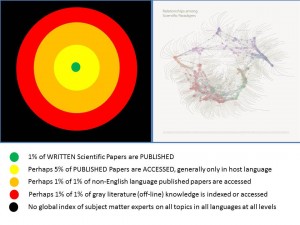
Open Source Everything Engineering (OSEE)
Let us now make the leap from the present infatuation with taking information technology toward the singularity goal of making humans redundant. Let us contemplate instead the wholeness of society – not just information society, but society across all physical domains. Imagine a world in which everything is open.
Most are familiar with the concepts of Open Source Software and Open Source Hardware. A few realize that these two concepts are insufficient to achieve anything resembling a singularity. Apart from the reality that a machine is utterly stupid without data, algorithms, and an audience, there is the small matter of civilization beyond the box — what else must be in being for society to advance?
Below is a starting point that I created with some help from Michel Bauwens, founder of the Peer to Peer (P2P) Foundation, and Marcin Jakubowski, creator of Open Source Ecology and the Global Village Construction Set.
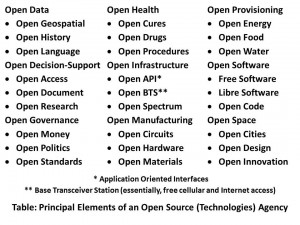
Toward Integrated Man-Machine Solutions
In my view, if we are to achieve exponential growth and infinite wealth for all humanity, we must integrate three intellectual concepts across all domains from agricultural to water: Holistic analytics (everything is connected), True cost economics (embrace the truth), and Open source everything engineering (affordable, inter-operable, and scalable).
There is much to be said about Eco-Villages and Transition Townes, and some small enclaves are eco-hacking the future with over one hundred different open-source applications toward a fossil-free zero-waste society. This is brilliant stuff, but it will not scale as quickly or, more pointedly, we can ask if it will even scale to any degree and in time so as to avoid the The Sixth Extinction: An Unnatural History. However much singularity aficionados may cheer for nirvana, time is the one strategic variable we cannot buy nor replace.
It is Smart Cities and Smart Nations that represent the very grand challenge of achieving a prosperous world at peace, a world that works for all. Everything being done now, from the Climate Change agreements to Paris to the Smart Cities initiative in India, is poorly thought through, unaffordable, and unachievable at scale – at sustainable scale. Only by embracing open source everything engineering across all technology domains can we create a prosperous world at peace, a world that works for all.
Embedded Intelligence
What is missing from the local to global conversation – apart from honest governance — is a shared grasp of how very important it is to integrate holistic analytics )for threats, policies, demographics) with true cost economics (cradle to grave for all artifacts all the time), and open source everything engineering.
Below is a depiction I created to improve on an existing program in the United Kingdom that purports to represent the state of the art in Embedded Intelligence – it was lacking the three essentials shown at the bottom of the graphic.
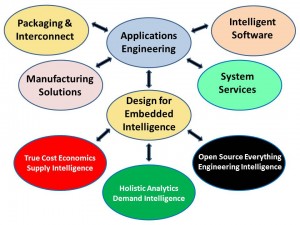
The technocracy has lost sight of the humanities – most of them have never read E. O. Wilson’s book, Consilience: The Unity of Knowledge and have no idea why the sciences need the humanities, a question that is answered most ably in this book.
Smart Cities and Smart Nations
To create a truly Smart City or Smart nation it is not acceptable to limits one’s definition of the necessities to broadband access. We must design cities by keeping firmly in mind what Bionic City pioneer Melissa Sterry suggests, that when nature is designing anything, it comes without fraud, waste, or abuse. Every single artifact must achieve what Buckminster Fuller called “ephemeralism,” avoiding all forms of waste.
For many this will mean pressed brick shelters and the fullest possible use of the Global Village Construction Set being created by Marcin Jakubowski. It will also mean broad acceptance of Peer to Peer forms of culture, economy, governance, and society as defined so ably by Michel Bauwens.
I have published an essay on Saving Civilization, delivered a memorandum to the Vice President of the United States on the need for an Open Source (Technologies) Agency, and provided a white paper to the Secretary General of the United Nations, so I will not belabor the elements here. My life’s work and my ambition for the future of humanity, are summed up in the below depiction of how I believe we must achieve man-machine intelligence with integrity across the whole.
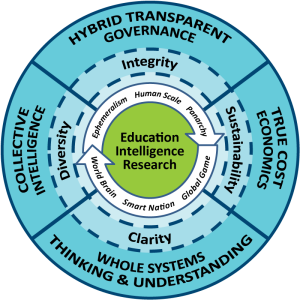
About the Author:

Robert David Steele Vivas is a former spy, Marine Corps infantry officer, honorary hacker, past presidential candidate, and the top Amazon reviewer devoted to non-fiction, reading in 98 categories. He pioneered Open Source Intelligence (OSINT), teaching over 7,500 professionals from across 66 countries how to achieve decision-support (intelligence) with legal ethical methods. Author of many books and articles on intelligence and electoral reform, over time he morphed into a proponent for Open Source Everything Engineering (OSEE), publishing The Open-Source Everything Manifesto: Transparency, Truth, and Trust in 2012. A 2014 profile of him in The Guardian by Nafeez Ahmed earned 33,000 “likes” in three days and now stands at 68,000 “likes.” Learn more about him at http://robertdavidsteele.com.



